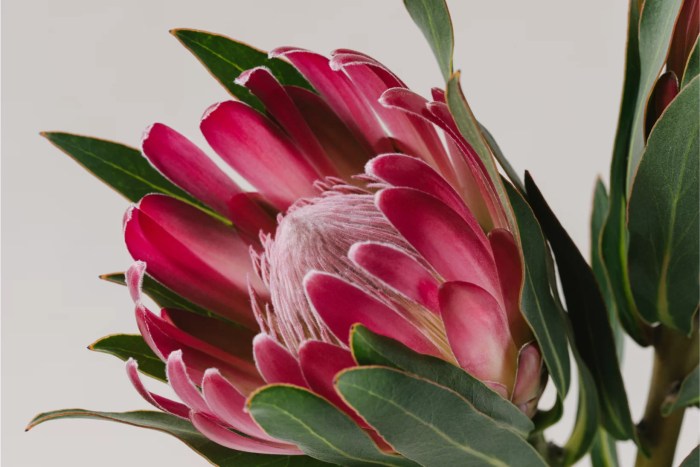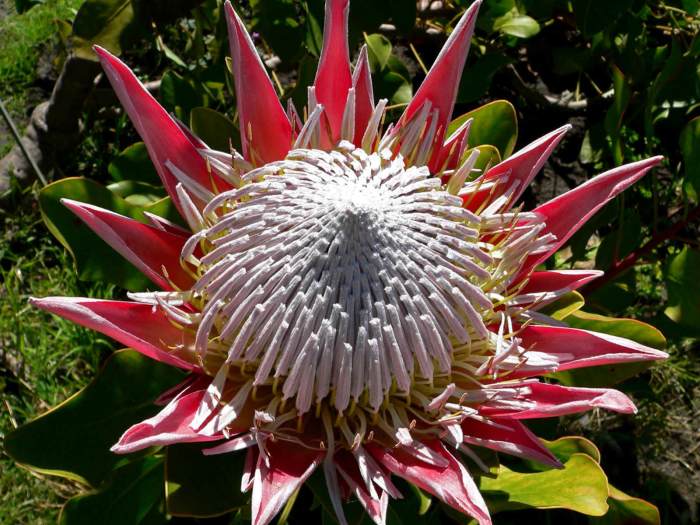Embark on an intriguing exploration of the large flower of Africa crossword, where we unravel the captivating world of the King Protea, the continent’s floral giant. Delving into its ecological significance, cultural symbolism, and conservation status, this discourse unveils the fascinating tale of this botanical marvel.
The Protea cynaroides, more affectionately known as the King Protea or Giant Protea, stands as a majestic symbol of Africa’s diverse flora. Its colossal flower head, adorned with vibrant bracts, captivates the senses and invites closer examination.
Introduction

In the diverse flora of Africa, large flowers play a significant role in attracting pollinators and showcasing the continent’s rich biodiversity.
African plants exhibit a remarkable array of large flowers with unique characteristics. These flowers often serve as a source of nectar and pollen for a variety of insects, birds, and mammals, ensuring the reproduction and survival of these species.
Examples of African Plants with Large Flowers
- Rafflesia arnoldii: Known as the “corpse flower,” this parasitic plant produces the largest single flower in the world, reaching up to 3 feet in diameter. It emits a strong, pungent odor to attract pollinating insects.
- Amorphophallus titanum: Also known as the “titan arum,” this plant produces one of the tallest inflorescences in the plant kingdom, reaching heights of up to 10 feet. Its massive flower releases a foul odor similar to rotting flesh, attracting carrion beetles for pollination.
- Stapelia gigantea: A succulent plant native to South Africa, Stapelia gigantea features large, starfish-shaped flowers with intricate patterns. The flowers emit a strong, unpleasant odor to attract flies for pollination.
- Strelitzia reginae: Commonly known as the “bird of paradise,” this plant produces vibrant orange and blue flowers that resemble a bird’s head. The flowers are pollinated by sunbirds and other small birds.
- Protea cynaroides: The national flower of South Africa, Protea cynaroides, produces large, showy flowers with a dense cluster of pink or red bracts. The flowers are pollinated by birds, insects, and small mammals.
Prominent African Flower
King Protea, Large flower of africa crossword
The largest flower in Africa is the Protea cynaroides, commonly known as the King Protea or Giant Protea. It is a striking and distinctive flower that is native to South Africa. The King Protea is characterized by its massive flower head, which can reach up to 12 inches in diameter.
The flower head is composed of hundreds of individual flowers, each of which is surrounded by showy bracts. The bracts are typically a deep pink or purple color, and they give the flower head a distinctive appearance. The King Protea is a popular flower for cut arrangements, and it is also used in traditional medicine.
Ecological Importance
Large flowers play a crucial ecological role by attracting a diverse array of pollinators, including birds, insects, and mammals. Their vibrant colors, sweet fragrances, and nectar-rich structures serve as irresistible beacons, drawing these animals to facilitate pollination and seed dispersal.
The King Protea: A Pollinator Haven
The King Protea ( Protea cynaroides) is an iconic South African flower renowned for its ecological significance. Its massive, showy inflorescence, which can reach up to 12 inches in diameter, is a magnet for a multitude of pollinator species.
- Birds:Sunbirds, sugarbirds, and even larger birds like the Cape sugarbird eagerly feed on the nectar of the King Protea, aiding in cross-pollination.
- Insects:Bees, flies, and beetles are drawn to the flower’s sweet fragrance and abundant nectar, contributing to its pollination success.
- Mammals:Small mammals, such as rodents and bats, also play a role in pollinating the King Protea by transferring pollen between flowers as they forage for nectar.
Cultural Symbolism: Large Flower Of Africa Crossword

Flowers, with their vibrant colors and intricate designs, hold significant cultural value in African traditions and folklore. The large, striking flowers of Africa are particularly revered, embodying profound meanings and playing essential roles in various cultural practices.
One of the most iconic examples is the King Protea, South Africa’s national flower. This magnificent bloom, with its regal presence, represents courage, strength, and transformation. In traditional ceremonies, King Protea bouquets are exchanged as symbols of love, respect, and admiration.
Art and Adornment
The large flowers of Africa have long inspired artists and artisans. Their intricate petals and vibrant hues have been incorporated into traditional textiles, pottery, and jewelry. The Maasai people of Kenya and Tanzania, for instance, adorn themselves with elaborate beaded necklaces featuring intricate flower motifs.
Ceremonies and Rituals
Flowers play a vital role in African ceremonies and rituals. In many cultures, flowers are believed to possess spiritual powers and are used to connect with ancestors, deities, and the natural world. The Xhosa people of South Africa use flowers in their traditional healing ceremonies, where they are believed to facilitate communication with the spirit world.
Festivals and Celebrations
Flowers are central to many African festivals and celebrations. During the annual Reed Dance in Swaziland, young women gather flowers to present to the Queen Mother as a symbol of their purity and readiness for marriage. In Ethiopia, the Enkutatash festival, marking the Ethiopian New Year, is celebrated with colorful flower arrangements and processions.
Conservation Efforts

The conservation status of large-flowered African plants, especially the King Protea, is a pressing concern due to habitat loss, climate change, and illegal harvesting. Conservation initiatives aim to protect these unique species.
Habitat Loss and Fragmentation
Habitat loss and fragmentation pose significant threats to large-flowered African plants. Urbanization, agriculture, and mining activities encroach upon their natural habitats, reducing their range and isolating populations.
Climate Change
Climate change exacerbates the threats faced by these plants. Changes in temperature and precipitation patterns affect their flowering and fruiting cycles, leading to reduced seed production and seedling survival.
Illegal Harvesting
Illegal harvesting for horticultural purposes poses a major threat to the survival of large-flowered African plants. The King Protea, in particular, is highly prized for its showy blooms, leading to over-collection from the wild.
Conservation Initiatives
Conservation initiatives are crucial to protect large-flowered African plants. These efforts include:
- Establishing protected areas to safeguard their habitats
- Implementing sustainable harvesting practices to prevent over-collection
- Raising awareness about the importance of these plants and promoting their conservation
- Conducting research to understand their ecology and develop conservation strategies
FAQ Compilation
What is the significance of large flowers in the African flora?
Large flowers play a crucial role in attracting pollinators, ensuring the reproduction and genetic diversity of African plant species.
How does the King Protea support pollinators?
The King Protea’s nectar and pollen provide sustenance for a wide range of pollinators, including birds, insects, and mammals, contributing to the ecological balance of African ecosystems.
What are the threats facing large-flowered African plants?
Habitat loss, climate change, and illegal harvesting pose significant threats to the survival of large-flowered African plants, including the King Protea.